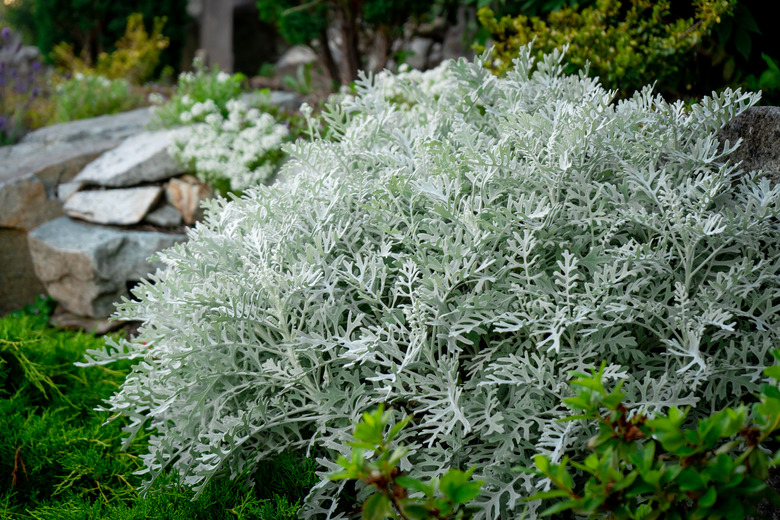How To Winterize Dusty Millers
We may receive a commission on purchases made from links.
Dusty miller is a tender perennial grown as an annual bedding plant in most gardens. These Mediterranean natives have silvery, felted foliage that makes a striking foil for colorful flowers. Some varieties have a lacy appearance. Dusty millers have been classified as both Senecio cineraria and Jacobaea maritima, but either label refers to the same plant that grows as a perennial subshrub in Mediterranean climates. Dusty miller thrives in full sun, well-drained soil, and hot weather.
In the United States, dusty miller is usually treated as an annual in USDA plant hardiness zones 7 and below. The leaves die back after temperatures drop below freezing, but new foliage can sprout in the spring if extra protection is provided. Gardeners in cooler climates can also bring dusty miller indoors until the risk of frost has passed. In its second year, dusty miller will grow up to 2 feet tall and produce yellow ray flowers.
Winterizing Dusty Miller Outdoors
Winterizing Dusty Miller Outdoors
Dusty miller can overwinter in the ground following the same guidelines used for many tender perennials. If your dusty miller is living in a pot, however, you should bring the plant indoors. The roots of potted plants are exposed to colder temperatures and are less likely to survive.
- Continue watering dusty millers during dry periods until the plants have gone completely dormant. Remove any brown foliage and stems that appear as temperatures begin to drop.
- Foliage will die back to the crown once temperatures regularly fall below freezing. Stop watering the plant and trim dead leaves and stems from your dusty millers to an inch or two above the crown.
- Mulch over the dusty millers with 4 to 6 inches of leaves, wood mulch, or straw if you live in a very cold winter climate. If you live in or near zone 7, then 1 or 2 inches of mulch should provide enough protection. If the plants are in an exposed area that is susceptible to wind, encircle the flower bed with chicken wire to hold the mulch in place.
- Remove the mulch from the flower bed in spring once any danger of frost has passed.
Overwintering Dusty Miller Indoors
Overwintering Dusty Miller Indoors
If your dusty miller is in a pot or you live in a particularly cold climate, bring the plants indoors for winter before freezing temperatures begin to damage the foliage. Dusty miller does not do well as a long-term houseplant, but it can survive in brightly lit areas until springtime arrives.
- If your dusty miller is not already in a pot, dig up the plant, taking care not to damage the root ball. Plant the dusty miller in fresh potting soil in a pot that's slightly bigger than the root ball. Set the pot in a shady area for a few days before bringing it inside.
- Spray the leaves with an insecticidal soap to prevent insects from hitchhiking a ride indoors, where they can infest your houseplants.
- Bring the pot indoors and set it in a brightly lit location. Water only when the top inch or two of soil is dry and do not allow the pot to sit in water. Trim back any leggy growth.
- Once the danger of frost has passed, gradually move the pot outdoors, beginning with a shady area for a few hours a day. Bring the pot indoors at night until evening temperatures remain above 40 degrees Fahrenheit. As the plant begins to acclimate to the outdoors, you can begin to gradually move it to sunnier areas and leave it outdoors longer. Once temperatures are consistently warm, you can leave your pot outdoors or replant dusty miller in the garden to join your spring annual flowers.
